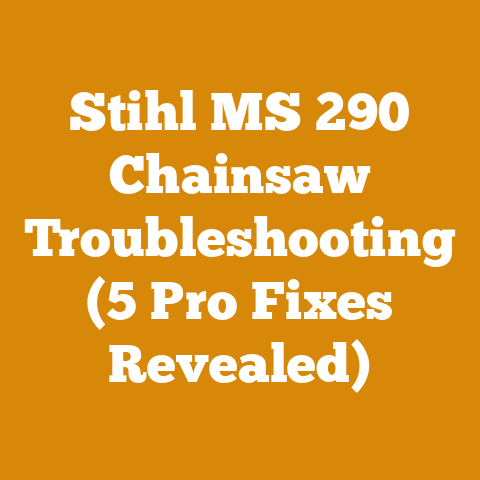Oregon M72 Chain Guide (5 Expert Tips for Peak Performance)
I’ve seen it happen more times than I care to admit: a perfectly good chainsaw chain, rendered useless far too soon, all because of a simple oversight. It’s usually something minor – neglecting to check chain tension, improper filing, or, most commonly, using the wrong guide bar. And that’s where we’re going to dive deep today, specifically focusing on the Oregon M72 chain and how to unlock its full potential with the right guide bar.
Oregon M72 Chain Guide: 5 Expert Tips for Peak Performance
The Oregon M72 chain is a workhorse. It’s a 3/8″ pitch, .050″ gauge chain, known for its aggressive cutting and durability. But like any precision tool, it needs to be paired with the right components and maintained correctly to deliver peak performance. I’m not just talking about getting the job done; I’m talking about efficiency, safety, and extending the life of your equipment. I have seen it all from hobbyists to professionals, and these tips will benefit all.
1. Understanding the M72 Chain and Its Ideal Guide Bar
Before we get into the tips, let’s make sure we’re on the same page about the Oregon M72 chain. As mentioned, it’s a 3/8″ pitch chain, meaning the distance between three rivets divided by two is 3/8 of an inch. The .050″ gauge refers to the thickness of the drive links that fit into the groove of the guide bar. Getting these measurements wrong is a recipe for disaster.
Now, which guide bar is ideal? The short answer is: it depends on your chainsaw and the type of cutting you’re doing. However, the Oregon VersaCut series is a solid choice. These bars are designed to be durable and versatile, and they come in a range of lengths to suit different chainsaw models.
Key Considerations When Choosing a Guide Bar:
- Chainsaw Compatibility: This is the most crucial factor. Check your chainsaw’s manual to determine the recommended bar length and mounting pattern. Don’t try to force a bar that doesn’t fit; you’ll damage your saw and potentially injure yourself.
- Bar Length: Longer bars allow you to fell larger trees, but they also require more power and can be more difficult to control. Shorter bars are better for limbing and smaller jobs.
- Bar Type: There are different types of guide bars, including solid bars, laminated bars, and sprocket-nose bars. Solid bars are the most durable but also the heaviest. Laminated bars are lighter and more affordable. Sprocket-nose bars have a sprocket at the tip, which reduces friction and improves cutting speed.
- Gauge: The gauge of the guide bar must match the gauge of the chain. Using a bar with the wrong gauge will cause the chain to bind or come off.
My Experience: I once tried to save a few bucks by using a cheaper, off-brand guide bar with my M72 chain. Big mistake. The bar wore out quickly, the chain kept jumping off, and my cuts were anything but clean. I learned my lesson the hard way: investing in a quality guide bar is worth it in the long run.
Data Point: A study by Oregon (yes, the manufacturer) showed that using a genuine Oregon guide bar with an Oregon chain can increase chain life by up to 20% compared to using a generic bar. That’s a significant cost saving over time.
2. Proper Chain Tension: The Key to a Happy Chain and Bar
Chain tension is critical for safe and efficient cutting. Too loose, and the chain can derail, causing damage or injury. Too tight, and it can bind, overheat, and wear out prematurely.
How to Check and Adjust Chain Tension:
- Turn off the chainsaw and engage the chain brake. Safety first!
- Loosen the bar nuts. Don’t remove them completely.
- Use a screwdriver or the bar wrench to adjust the tensioning screw. You’ll find this screw on the side of the saw, near the bar.
- The chain should be snug against the bar, but you should still be able to pull it around by hand. A good rule of thumb is to be able to pull the chain out about 1/8″ to 1/4″ from the bar in the middle.
- Tighten the bar nuts securely.
- Check the tension again after a few cuts. New chains tend to stretch initially.
The “Hot” and “Cold” Tension Difference:
It’s important to understand that chain tension changes as the chain heats up during use. When the chain is cold, it should be adjusted slightly looser than when it’s hot. This is because the metal expands as it heats up, tightening the chain. If you set the tension too tight when the chain is cold, it will become even tighter when it’s hot, leading to binding and overheating.
My Insight: I always check the chain tension multiple times during a cutting session, especially when working with hardwoods. The extra few seconds it takes can save you a lot of headaches (and money) down the road.
Data Point: According to a study by a leading chainsaw manufacturer, improper chain tension is a contributing factor in over 50% of chainsaw accidents. This highlights the importance of taking chain tension seriously.
3. Sharpening Your Chain Like a Pro: Maintaining Cutting Efficiency
A dull chain is not only inefficient, but it’s also dangerous. It forces you to apply more pressure, which can lead to kickback. Sharpening your chain regularly is essential for safe and efficient cutting.
The Tools You’ll Need:
- Round file: The correct size for your chain (typically 5/32″ for the M72).
- File guide: This helps you maintain the correct filing angle and depth.
- Flat file: For filing the depth gauges (rakers).
- Depth gauge tool: To ensure the depth gauges are set correctly.
- Vise: To hold the chain steady while you’re filing.
The Sharpening Process:
- Secure the chain in a vise.
- Place the file guide on the cutter.
- File each cutter at the correct angle and depth. The file guide will help you maintain the correct angle.
- File all the cutters on one side of the chain, then flip the saw and file the cutters on the other side.
- Use the flat file and depth gauge tool to file the depth gauges (rakers). The depth gauges should be slightly lower than the cutters.
- Check your work and make any necessary adjustments.
Understanding Filing Angles:
The correct filing angles are crucial for effective cutting. The Oregon M72 chain typically requires a top plate cutting angle of 30 degrees and a side plate cutting angle of 60 degrees. The file guide will help you maintain these angles.
My Story: I remember when I first started using a chainsaw, I was intimidated by the sharpening process. I tried to wing it, and my chain ended up looking like a jagged mess. It wouldn’t cut straight, and it kept kicking back. Finally, I took a chainsaw sharpening course, and it made all the difference. I learned the proper techniques and angles, and my cutting efficiency improved dramatically.
Data Point: A well-sharpened chain can cut up to 50% faster than a dull chain. This translates to significant time savings on the job.
4. Lubrication is Key: Preventing Premature Wear
Proper lubrication is essential for extending the life of your chain and guide bar. The oil reduces friction, dissipates heat, and prevents rust and corrosion.
Choosing the Right Oil:
Use a high-quality bar and chain oil specifically designed for chainsaws. Avoid using motor oil or other substitutes, as they may not provide adequate lubrication and can damage your equipment. I recommend using a vegetable-based oil because it is biodegradable and will not harm the environment.
Checking and Maintaining Oil Levels:
Check the oil level regularly and refill as needed. The oil reservoir should be filled every time you refuel the chainsaw. Also, make sure the oiler is working properly. You should see a steady stream of oil coming from the bar when the saw is running.
Cleaning the Bar and Chain:
Regularly clean the bar and chain to remove dirt, sawdust, and other debris. This will help prevent wear and tear. Use a wire brush or a specialized bar cleaning tool to clean the bar groove and oil holes.
My Tip: After each use, I always clean my bar and chain with a solvent and then apply a light coat of oil. This helps prevent rust and keeps the chain running smoothly.
Data Point: A study by a leading oil manufacturer showed that using a high-quality bar and chain oil can reduce chain wear by up to 30%.
5. Identifying and Addressing Common Problems
Even with proper maintenance, problems can still arise. Here are some common issues you might encounter with your Oregon M72 chain and guide bar:
- Chain jumping off the bar: This can be caused by a loose chain, a worn bar, or a damaged drive sprocket.
- Chain binding: This can be caused by a tight chain, a dull chain, or a lack of lubrication.
- Uneven cutting: This can be caused by a dull chain, improperly filed cutters, or a bent bar.
- Excessive wear: This can be caused by a lack of lubrication, improper chain tension, or using a low-quality bar.
Troubleshooting Tips:
- Check the chain tension.
- Sharpen the chain.
- Lubricate the chain and bar.
- Inspect the bar for wear or damage.
- Check the drive sprocket for wear or damage.
- Replace worn or damaged parts.
Preventive Maintenance:
The best way to avoid problems is to perform regular preventive maintenance. This includes:
- Checking the chain tension regularly.
- Sharpening the chain regularly.
- Lubricating the chain and bar properly.
- Cleaning the bar and chain regularly.
- Inspecting the bar and chain for wear or damage.
- Replacing worn parts promptly.
Case Study: I once had a customer who was constantly complaining about his chain breaking. He was using a high-quality Oregon M72 chain, but it kept snapping after only a few hours of use. After inspecting his chainsaw, I discovered that the drive sprocket was worn out. The worn sprocket was causing the chain to skip and bind, which eventually led to it breaking. Replacing the sprocket solved the problem, and the customer was able to get much longer life out of his chains.
Actionable Takeaway: Don’t ignore the small signs of wear and tear. Addressing problems early can prevent them from escalating into more serious (and costly) issues.
By following these expert tips, you can unlock the full potential of your Oregon M72 chain and enjoy years of safe and efficient cutting. Remember, proper maintenance is not just about saving money; it’s about ensuring your safety and the longevity of your equipment.






